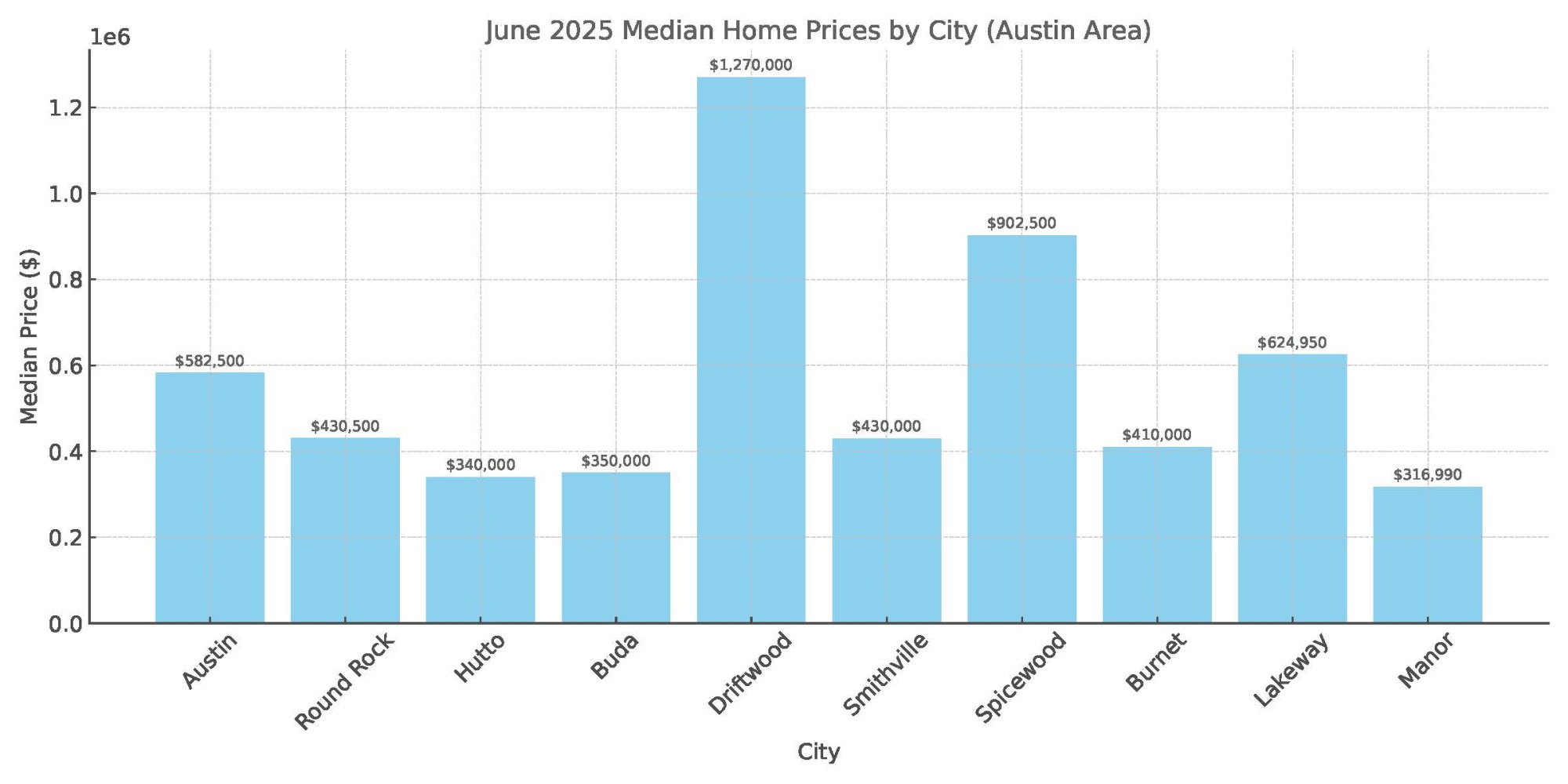June 30, 2025: The Austin-area real estate market continued to shift in June 2025, with updated median sold prices reported across 30 cities. The data, compiled by Team Price Real Estate, shows both gains and losses across the region when compared to last month, last year, and previous market peaks.
Austin's median sold price for June 2025 was $582,500. This represents a 1.3% decrease from the previous month and a 15% drop compared to the market peak of $680,000 in May 2022. Overall, the city is down 4.5% from 2022. Neighboring cities also show a range of results. Round Rock reported a median price of $430,500, nearly flat from last month but 13.9% lower than in 2022 and 22% below its peak of $552,000.
Several cities posted gains in June. Burnet led the month-over-month increases with a 33.3% jump to $410,000. It is also up 5.1% from 2022, though still 38.8% below its peak of $670,000 in January 2024. Smithville posted the largest year-over-year increase at 57.8%, with a current median of $430,000. Despite this growth, it remains 30.6% below its January 2025 high of $620,000.
Spicewood also showed strong growth with a median of $902,500—up 46% year-over-year and 5.6% above 2022. Marble Falls saw its median price increase 35.9% compared to last year, reaching $509,500, though still nearly 50% below its April 2023 peak of $1 million. Driftwood climbed to $1.27 million, marking a 20.8% increase from last month and a 22.1% year-over-year rise.
On the lower end, Lakeway had the largest price drop in June, falling 29% to $624,950. This is also a 28.9% year-over-year decrease and 34.9% below its peak of $959,990 in November 2023. Buda dropped 1.4% from last month and 24% from 2022, with a current median of $350,000—28.6% below its peak. Manor fell 10.9% in June and is down 22.9% from 2022, with a median price of $316,990.
In Hutto, the median price was $340,000, down 3.4% from May and 18.9% lower than 2022. Jarrell followed a similar trend with a median of $271,990, falling 1.1% month-over-month and down 19.3% from 2022. San Marcos, Leander, and Elgin also saw year-over-year declines of 6.1%, 4.5%, and 5.2%, respectively.
Across the region, the average drop from market peak prices was 25.3%. From 2022, the average decline across all cities was 7.7%. These numbers highlight that while some cities are rebounding or stabilizing, many still remain well below their recent market highs.
Frequently Asked Questions:
1. What’s driving record-high home inventory in the Austin area?
Record-high active listings—over 17,800 homes as of late June—are driven by two key trends. First, new listings are up about 25% above long-term averages, with sellers responding to shifting market conditions. Second, buyer demand has slowed, pulling pending sales down by 11–12% year-over-year. This imbalance increases competition among sellers, with negotiation power shifting toward buyers.
2. How far have Austin-area home prices fallen from their peak?
Median sold home prices peaked in May 2022—Austin at approximately $550,000. By June 2025, most cities are still 20–30% below those highs. Austin itself is down 15% from its peak, with a June median of $582,500 versus $680,000 in May 2022. Round Rock dropped 22% from its $552,000 peak. Lakeway fell roughly 35%, and Smithville, despite strong gains, remains nearly 31% below its January 2025 high.
3. How long will it take Austin home values to recover fully?
Assuming the current correction is the bottom, historical trends suggest recovery will be gradual. Austin's long-term compound annual appreciation rate is about 5% per year. At that pace, median values could return to mid-2022 peaks in approximately 4 to 4.5 years—meaning full recovery may occur between early 2029 and mid‑2029.
4. Why is affordability still fragile even with price declines?
Even though median prices have dropped, affordability remains constrained by high mortgage rates (around 6–7%) and slow wage growth. As a result, mortgage payments remain high, pushing affordability to near historic lows. One estimate notes Austin is at a 40-year low in housing affordability when factoring in price, income, and interest rates. Rising inventory may ease pressures, but affordability hinges heavily on interest rates and incomes.
5. Is now a good time to buy or sell in Austin?
For buyers, the current market presents opportunity: high inventory, growing price reductions, and slower sales create room for negotiation. Nearly 50–56% of listings are showing price cuts. For sellers, caution is needed—properties priced too high face longer time on market. Pricing strategically, staging effectively, and offering concessions are critical to succeed.





